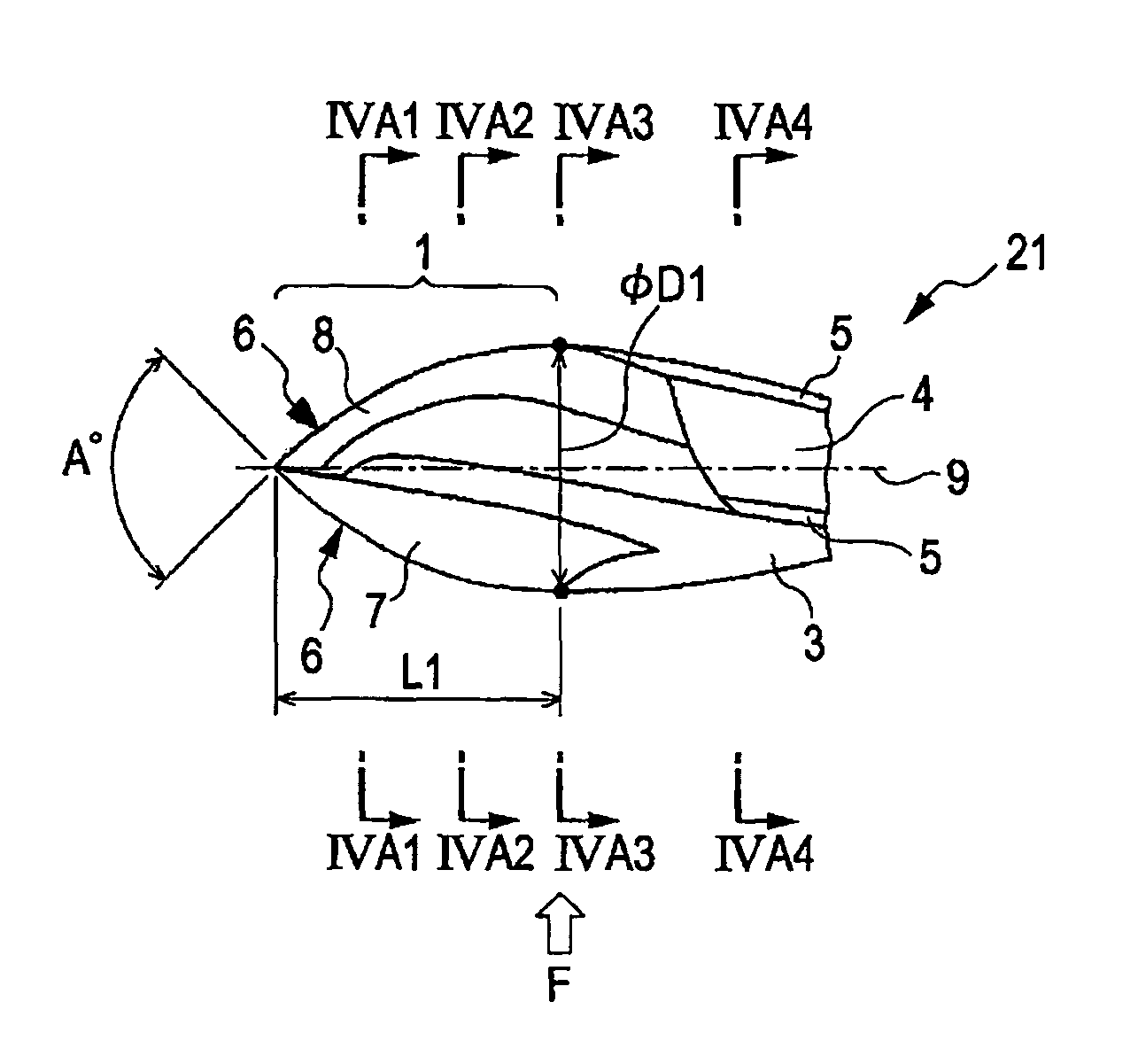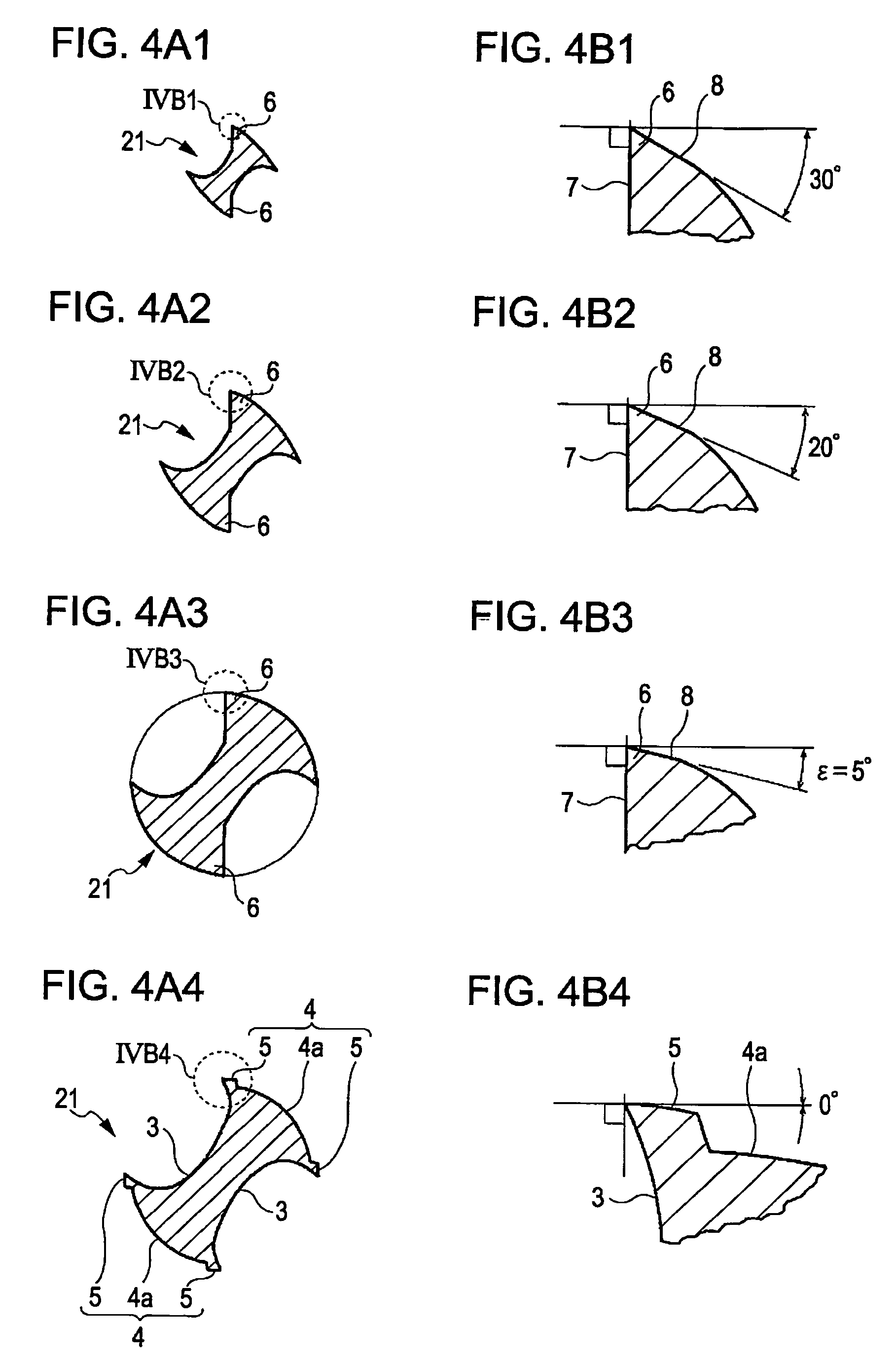Drill and drilling method for workpiece
a drilling method and workpiece technology, applied in the direction of twist drills, manufacturing tools, wood boring tools, etc., can solve the problems of reducing the wear resistance of the drill bit, the cutting edge wear resistance of the double angle drill bit is not high, and the drill bit wear resistance is low. to achieve the effect of high precision drilling and increased cutting edge wear resistan
- Summary
- Abstract
- Description
- Claims
- Application Information
AI Technical Summary
Benefits of technology
Problems solved by technology
Method used
Image
Examples
first embodiment
[0047]A first embodiment of the present invention is described below with reference to FIGS. 1 to 4B4. FIG. 1 is a side view showing a drill according to the first embodiment of the present invention.
[0048]Referring to FIG. 1, a drill 21 of this embodiment includes a cutter section 1 and a shank section 2. Helical flutes 3 are formed on the cutter section 1 and the shank section 2.
[0049]FIG. 2 is an enlarged view showing a tip portion of the drill 21 in FIG. 1.
[0050]The cutter section 1 includes a pair of cutting edges 6 arranged symmetrically about an axis 9. The cutting edges 6 each have a rake face 7 and a relief face 8.
[0051]The cutter section 1 is finished by X thinning (cross thinning), and rake faces 7 are formed at portions removed by thinning. The portions removed by thinning are continuous to the helical flutes 3. The helical flutes 3 are two threads which are twisted at a predetermined helix angle. Lands 4 are formed between the helical flutes 3. Margins 5 are formed at e...
second embodiment
[0068]Next, a second embodiment of the present invention is described. FIGS. 7A1 to 7B4 are cross-sectional views each showing a drill according to the second embodiment of the present invention. The positional relationship of the cross sections is similar to that of FIGS. 2A1 to 2B4. A drill 22 of this embodiment includes a cutting edge having a rake angle and is suitable for metal processing.
[0069]Referring to FIGS. 7A1 to 7A3, and 7B1 to 7B3, a cutting edge 6a has a rake angle. In particular, the cutting edge 6a has a rake face 7a inclined toward a relief face 8 with respect to a line 10 orthogonal to a work surface. Other structure is similar to that of the drill 21 of the first embodiment. Dimensions of respective parts are designed depending on the purpose of use.
[0070]When the drill 22 is applied to metal processing, for example, referring to FIG. 8, the slenderness ratio (L1 / φD1) of a cutter section 1 is set smaller than that for a composite material. In this case, the ridge...
third embodiment
[0071]Next, a third embodiment of the present invention is described. FIG. 9 is a cross-sectional view showing a drill according to the third embodiment of the present invention. FIG. 10 is a cross-sectional view taken along line X-X in FIG. 9. A drill 23 of this embodiment is configured such that the helical flutes 3 of the drill 21 in the above-described first embodiment are replaced by V-grooves 11.
[0072]Referring to FIG. 9, the drill 23 includes a cutter section 1b and a shank section 2. The cutter section 1b includes a pair of cutting edges 6b arranged symmetrically about an axis 9. The cutting edges 6b each have a rake face 7b and a relief face 8b. Referring to FIGS. 9 and 10, two V-grooves 11 are formed between the cutter section 1b and the shank section 2. The V-grooves 11, including a removed portion of the cutter section 1b by thinning, are formed straight along the axis 9.
[0073]Referring to FIG. 10, lands 12 are formed between the V-grooves 11, and margins 13 are formed a...
PUM
| Property | Measurement | Unit |
|---|---|---|
| point angle | aaaaa | aaaaa |
| angle | aaaaa | aaaaa |
| relief angle | aaaaa | aaaaa |
Abstract
Description
Claims
Application Information
 Login to View More
Login to View More - R&D
- Intellectual Property
- Life Sciences
- Materials
- Tech Scout
- Unparalleled Data Quality
- Higher Quality Content
- 60% Fewer Hallucinations
Browse by: Latest US Patents, China's latest patents, Technical Efficacy Thesaurus, Application Domain, Technology Topic, Popular Technical Reports.
© 2025 PatSnap. All rights reserved.Legal|Privacy policy|Modern Slavery Act Transparency Statement|Sitemap|About US| Contact US: help@patsnap.com



